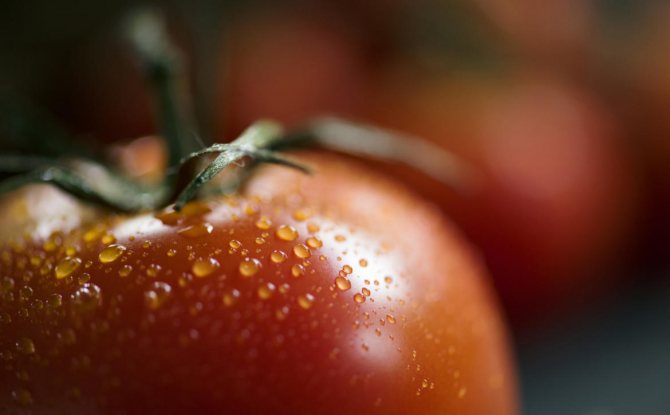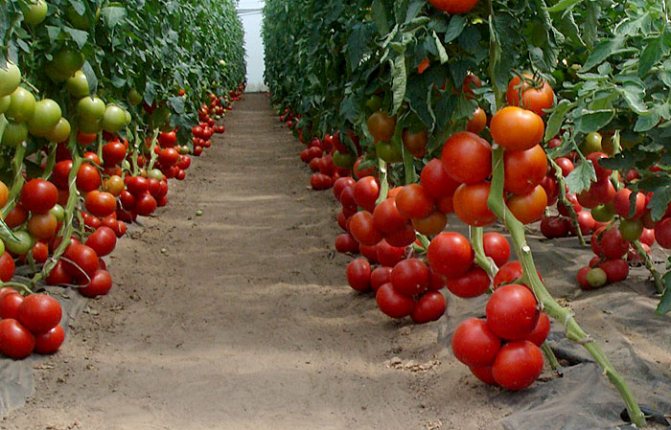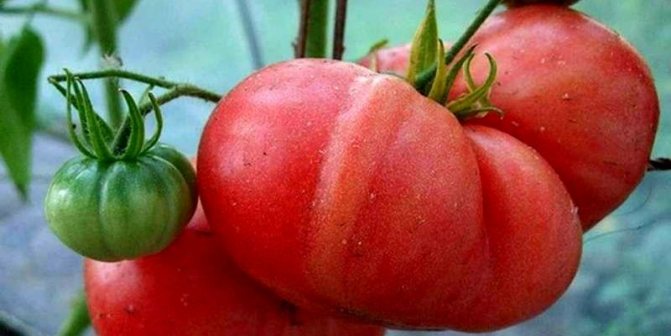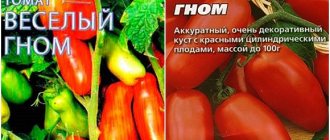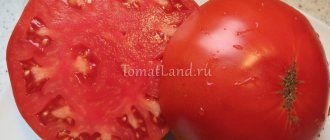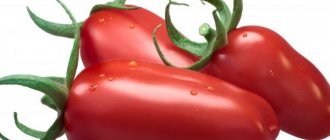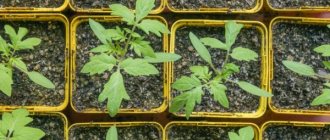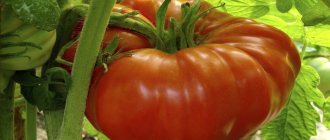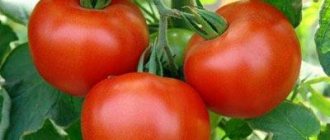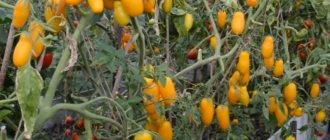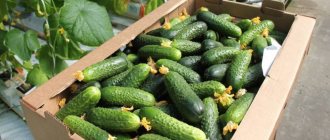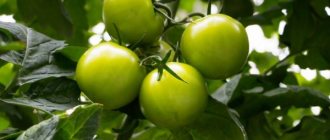Vegetable growing »Tomatoes
0
1394
Article rating
Before growing tomatoes, the gardener wonders which variety to choose. The Ural Giant tomato is perfect for people who want to grow huge fruits with excellent taste and aroma. Growing it does not require more effort than other varieties, and the result will delight everyone.
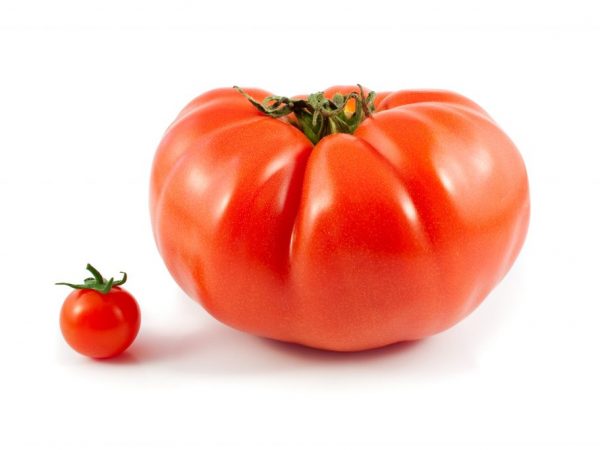
Characteristics of the Ural Gigant tomato variety
Characteristics of the Ural Gigant tomato variety
Before growing tomatoes, the gardener wonders which variety to choose. The Ural Giant tomato is perfect for people who want to grow huge fruits with excellent taste and aroma. Growing it does not require more effort than other varieties, and the result will delight everyone.
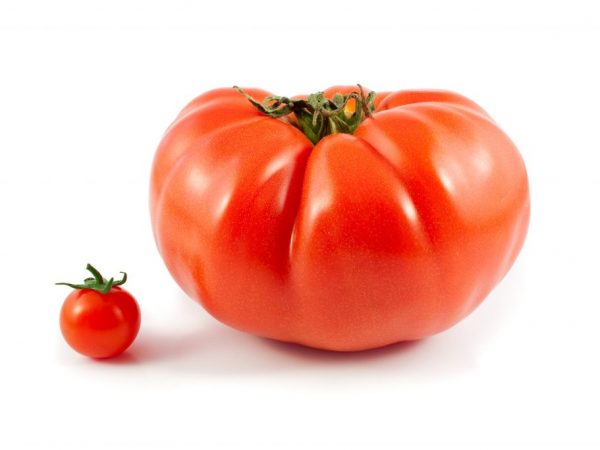

Characteristics of the Ural Gigant tomato variety
This is a new generation large-fruited variety that unites 4 species. They differ from each other only in fruits, which can be of different colors. You can grow red, pink, yellow (lemon) and orange tomatoes.
Each has its own taste, aroma and pluses. Giant red contains very healthy lycopene in abundance. Pink - has rather sweet fruits. Yellow - has a spicy taste, and orange - delicate, with a high content of carotene.
Description of the bush
Compared to other representatives of large-fruited varieties, the Ural Gigant is considered early maturing. The bush is liana-shaped, indeterminate, therefore it reaches a large size. During the season, it grows in height by 1.5 m. If you do not tie it up in time, the culture will grow horizontally or break. Grown both in greenhouses, greenhouses, and in open areas of soil.
Description of fruits
The fruits are fleshy, juicy and sweet. In the description of the Ural giant tomato, it is stated that their mass reaches 600-800 g. But there are vegetables and large sizes. Their top is flattened, the shape is rounded. They have a lot of cameras. The skin is thin. Used fresh for salads. Perfect for making sauces, ketchups and juices.
Processing
Like most fleshy salad-type tomatoes, the fruits of the Ural giant cannot boast of long keeping quality. Part of the harvest must be put into winter harvesting on time.
The simplest, without sterilization - "gorloder" ("horseradish"), with garlic, horseradish root, hot pepper. Especially successful is tomato juice with a small addition of salt: ideal consistency, fragrant, very healthy. You can cook thick tomato paste, lecho, make vegetable mixtures with sterilization. An exquisite delicacy - multi-colored tomato slices in a jelly marinade.
Advantages and disadvantages
- High yield - from 1 sq. m. per season, with proper care in the greenhouse, you can collect 12-15 kg of tomatoes. Since the plant is large, one brush can carry 3-5 ovaries. Therefore, the area allocated for cultivation is used as efficiently as possible.
- High taste and pleasant aroma.
- Cracking resistance.
- Usefulness - the fruits contain a large amount of vitamins and minerals.
- Excellent tolerance to cold and heat - due to this property, tomatoes are grown in regions with a harsh climate and in more southern regions.
The disadvantage of this variety is its susceptibility to diseases and pests.Often, a culture cannot withstand late blight and other fungal infections. In addition, it is difficult to deliver the fruit to other locations, for example, for sale. After all, they are large, and the skin is thin. Therefore, during transportation, they lose their presentation.
Before planting the Ural giant tomato, it is worth fertilizing the soil. This is done in the fall, in the third decade of November. Wood ash, chicken droppings, or other organic matter are added. After that, they dig up the soil.
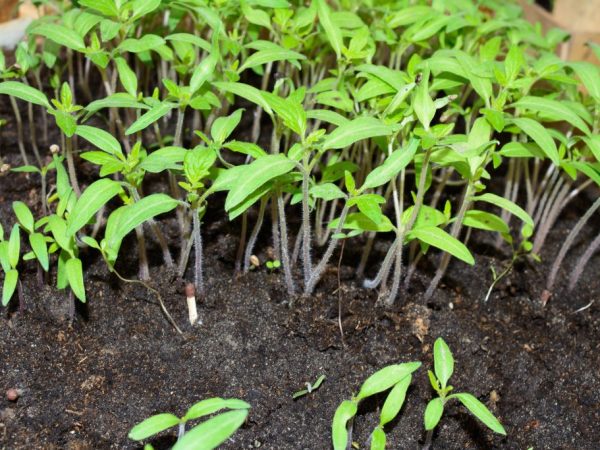

Seedlings should be transplanted when two true leaves appear.
The plant is planted by seedling method:
Seeds are sown in March and early April. Deepen by 1 cm. Germinated seedlings are transplanted when they have 1-2 true leaves. Before disembarking to a permanent place, they are tempered for 7-10 days. If a greenhouse growing method is chosen, then it is worth planting seedlings in April-May. Its age should be about 60-65 days. They are planted in open ground after the end of spring frosts, when there are already 6-7 true leaves and at least one flower brush. Fertilizers are applied to the holes. The planting pattern should be 30 × 50 cm.
To get a high yield, you need to make efforts, which include:
- the formation of bushes;
- garter;
- watering;
- top dressing;
- pest control.
Bush formation
Since the plant has the property of unrestrained growth, it is necessary to control its size. Otherwise, the harvest will not be good. For the correct formation of the bush, do pinching and edging. Throughout the growth of the culture, side shoots are removed. So that new branches do not grow in their place again, it is necessary to leave a stump of 1.5-2 cm in size when breaking off.
Provided there is sufficient nutrition, only one stepson can be left - above the first brush. When the plant reaches the desired height (1.5-2 m), pinch its top. In this case, 2-3 leaves are left above the brush. Thanks to such manipulations, the plant will direct all its energies to the formation and pouring of fruits. To grow huge vegetables, one ovary is left in the cyst.
In order for the tomatoes not to fall or break due to the severity of the fruit, it is worth tying them up. For this purpose, vertical trellises can be made. Plants are wrapped around them, and the brushes with fruits are tied up separately.
Water the tomatoes with warm water after sunset. Watering is carried out regularly every 2 days, but in moderation.
Fertilizers are applied throughout the entire growth period, at least 2 times a month. Top dressing is carried out with both organic and mineral substances. It is worth considering your capabilities before planting the Ural giant, since it is impossible to grow fleshy fruits without fertilizers.
Disease prevention
For the prevention of fungal diseases, spraying with an environmentally friendly drug Fitosporin is carried out. If the culture is already infected, chemicals are used, which can be bought in specialized stores.
Tomato care
Tall bushes form into 1 or 2 stems, removing side shoots. When the plant reaches the desired height, pinch the growth point.
The stems are tied to a trellis, but besides - and brushes with heavy fruits. The number of flowers is normalized as needed (the fewer flowers, the larger the fruit will turn out). Plants are watered once a week - with warm water under the root.
After watering, the soil is well loosened and weeded. To retain moisture in the soil and reduce the number of weeds, the garden bed can be mulched (with peat, hay, dry leaves, etc.).
The large-fruited variety needs frequent feeding - they are done every two weeks, alternating organic fertilizers with mineral complexes. They can be combined with watering using liquid or water-soluble fertilizers.
After planting, the plants are left alone for a while for full adaptation. Watering during this period is not needed, and the first time tomatoes are watered no earlier than a week later.
They loosen the soil, remove the weeds, which at this very time begin to grow violently. After about 18-20 days, the first feeding is carried out using a diluted mullein (1:10) or complex fertilizers (nitrophosphate).
In tomato agricultural technology, an important place is given to irrigation. They should be moderate, regular, and abundant. It is optimal to equip the shelter with a drip irrigation system, but this is not always possible.
Most often, summer residents usually water it - from a watering can, a hose, while it is recommended to use holes or grooves. Flowing water can erode the soil at the roots of plants, and if grooves are made, the soil will be moistened evenly, the water will reach the roots.
ON A NOTE! Tomatoes are watered with warm and settled water.
The norm for each plant is about 3-4 liters, during the period of flowering and fruit setting, the volumes increase. For tomatoes in open ground, rains are a good help; in a greenhouse, all watering is assigned to a person. It is important not to allow high humidity in the shelter, otherwise the tomatoes will hurt.
Abrupt breaks in the watering schedule lead to cracking of the tomatoes. Although the Raspberry Giant variety is not prone to cracking the fruit, with long pauses in irrigation, cracks and splits may appear on these tomatoes.
The feeding schedule must also be adjusted to ensure that the plants receive all the nutrients they need. After the first feeding, take a break of about 10-14 days and spend the second, using mineral phosphorus and potash fertilizers instead of organic matter.
They love watering tomatoes with ash infusion, as well as "green tea" - herbs infused with water. It is impossible to violate the dose of fertilizers, to introduce a lot of nitrogen, from which the plants "fatten", and the number of ovaries is reduced.
Tomatoes need nitrogen in the first half of the growing season, while later plants need potassium and phosphorus. Good results are obtained by watering tomatoes with banana peel infusion, baker's yeast. In stores, you can buy ready-made compositions for watering tomatoes, which contain all the nutrients necessary for the culture.
Do not forget about foliar dressing, which is very effective in cloudy weather. The assimilation of nutrition in this form is much faster, tomatoes bloom profusely, form fruits faster.
This variety is most often formed into one stem, less often into two. The raspberry giant needs partial pinching, for which the lateral shoots are removed in the axils below the flower brushes.
The variety is quite resistant to diseases and pests, it manages to "go away" from phytophthora due to the early ripening of fruits. But prevention is needed in any case, therefore, from the end of June, plants are sprayed with special formulations:
- boric acid (one teaspoon is taken for 10 liters);
- Epin, Oxygumat (diluted according to the instructions for the drug);
- infusions of garlic, wood ash.
It is recommended to dust tomatoes in open ground with dry ash, as well as a mixture of ash and tobacco dust. This treatment helps protect plants from insect pests.
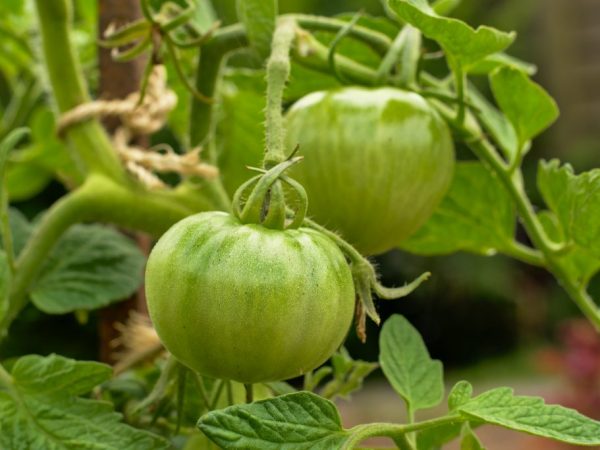

The fruits are harvested in a state of technical maturity, although in a greenhouse you can let the tomatoes fully ripen on the bush. Harvesting green fruit allows the plant to channel its forces into the formation of tomatoes in other clusters, which helps to increase the overall yield from the bushes.
To get a good harvest, it is necessary to tie up the bushes, carry out their formation, water them on time, make additional fertilizing and admonish against diseases.
Formation
- The bushes are constantly growing, and therefore require formation in the sense of the season. If this is not done, the yield will be low. It is necessary to dismiss the stepsons and carry out edging.
- If the plants are well supplied with food, in this case, it is allowed to leave 1 stepson over the first brush.When the bush reaches a height of more than 150 cm, you should pinch the top. Above the brush, you need to stop several leaves. Pinching will allow the plant to spend energy only on top of the fruit.
Garter Fruits grow large, so the bush must be tied up. (passion is convenient to use vertical trellises. The bush is wrapped around, and the hands are tied up, respectively, separately.
Watering Watering should only be with warm water. It needs to be repaired after dusk. Watered every 2 days, so in moderation.
Fertilization should be applied during the season, at least every 2 weeks. Both mineral and organic fertilizing are useful. If you do not apply fertilizers regularly and in sufficient quantities, you will not be able to grow fleshy and large fruits.
It is difficult to call this information official and reliable, since the variety is not included in the register of breeding achievements of the Russian Federation. The true origin of the tomato cultivar is unknown.
The variety came to the market under the patronage and counterpart "Northern Vegetables". The company itself does not have information about the variety, nor can it explain the origin.
Variety information
Since the variety has not been tested at variety testing stations under the supervision of breeders, the information can only be partially trusted.
The variety is presented as determinant, undersized, standard. Those growers who succumbed to the picture and grew, describe the plant as up to 50 cm high with a small leaf plate.
The central shoot of the vegetative form is very resistant. The plant looks like a small tree. Fruits are formed by spreading brushes.
Variety of early ripening, subject to sowing seedlings in early March.
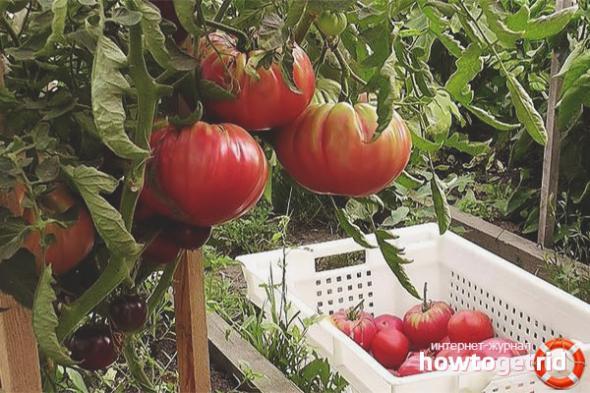

Fruits are round and flat-round in shape, not large, but not cherry. In the period of full biological maturity, a rich red color. When cut, it is clearly visible that the pulp is dark red in color.
Tomatoes are a good size to fit into the neck of a seaming can. However, there is no information on how exactly the variety behaves during heat treatment.
Considering the "Uralsky Early" tomatoes, reviews for sustainability are not unambiguous.
Those vegetable growers who grew tomatoes in greenhouses speak of the extreme resistance of the variety, but in the open field, tomato bushes were the first to be struck by late blight and they could not get at least some kind of harvest.
Experienced vegetable growers do not rely on the mercy of nature and are well aware that there is not a single completely resistant variety, therefore, preventive treatments are the basis for the well-being of the crop.
For Uralsky Early, the most preferable processing scheme will be the following:
- First processing after planting in open ground;
- The second in 15-20 days;
- The third again after 15-20 days
- Further, every 10 days after harvest, with preparations with a short waiting period after processing.
To get a high-quality harvest, you need:
- Select disease-resistant varieties;
- Carry out preventive treatments regardless of the variety;
- The multiplicity of treatments should be compared with weather conditions;
- Do not use the same fungicidal preparations for many years;
- During the season, carry out alternating treatments with drugs of different directions with different active principles.
Watered with warm water in the evening, add liquid under the root. Loosens the soil to provide oxygen access to the roots.
Stepchildren and tie up the bush.
With an interval of about three weeks, top dressing is applied, preferably complex mineral fertilizers. Young bushes are fed with humus or bird droppings. Periodic feeding with home remedies is effective: a solution of yeast under the root or a solution of boric acid, hydrogen peroxide, iodine on the sheet.
Expert opinion
Valentine Rarely
Chief editor Repka.online. An experienced summer resident and gardener.
The Ural giant pink tomato is less known than other varieties of large Ural tomatoes, but it is not inferior to them. The variety wins hearts with its wonderful taste.
Feedback from those who grew 0 ″> Order by:
Natalia 09/13/2019, 12:26 PM
Verified
City: Vladivostok Where they grew up: Open groundProducer: Private collector Show more
Tomato King of Giants
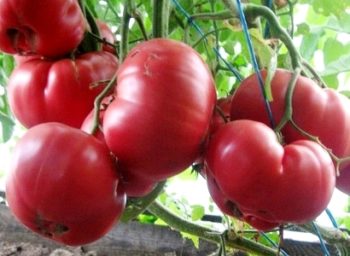

The closer the time for planting tomato seeds to get seedlings, the more difficult it is for gardeners to choose which ones to plant. I would like the germination capacity to be large, and the seedlings are strong, and the yield is greater. And the tomatoes themselves are desirable large, tasty.
Read also: 7 varieties of De Barao tomato: black, pink, gold, royal, giant, red
Among the variety of varieties, a well-deserved recognition stood out the new King of Giants tomato.
Typical mistakes
One of the most common mistakes when growing this variety is the lack of light in the greenhouse. A lack of sunlight negatively affects the taste of fruits, their size and yield. The formation of bushes and thinning of leaves helps to increase the access of light to the plant.
Some gardeners call the Azure giant tomato variety Radiant or Sugar. The tomato is a mid-season tomato, and the Early Giant ripens a couple of weeks earlier. Connoisseurs of the unusual color of tomatoes speak positively about this variety.
Characteristics and description of the variety with a photo
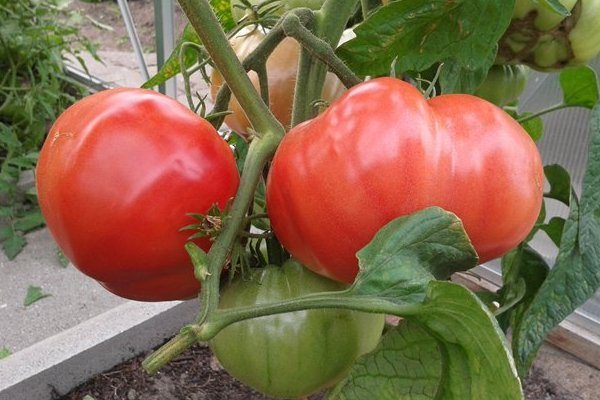

A sprawling tomato bush grown in greenhouses easily reaches 2 meters. On open beds, its height is slightly less - 1.6 meters. With such a significant growth, the culture has a very fragile stem, therefore, you cannot do without tying it up.
When the plant has released the 9th leaf, the formation of ovaries will begin. This will happen about 16 weeks after the seedlings are planted. Thus, one can judge about the belonging of the variety to the mid-season. Brushes are scattered densely along the stem, every 3-4 leaves.
The ripe fruit is bright red, but pink shades are also found.
Interesting! The characteristic attributes the King of Giants to salad varieties, but gardeners use it as a universal tomato.
Almost all fruits of open ground reach a weight of 600 g, while in greenhouses, proper care will allow them to grow up to 800 g. There have been cases when tomatoes set a weight record of 1 kg.
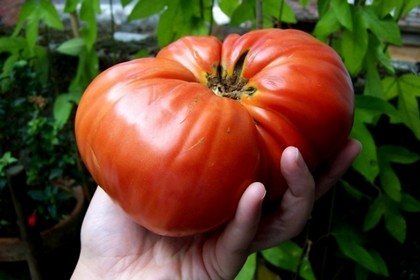

The fruits themselves are juicy, with delicate fleshy pulp, which is protected by dense skin. For all the sweetness of the taste, the presence of sourness is quite clearly felt. Tomatoes do not form many chambers, only 8, no more.
Summer residents who have been growing this variety for several years have noticed that harvest cannot be delayed, it is better if the fruit does not ripen a little. An overripe tomato bursts instantly, loses its juiciness and appearance.
Positive and negative qualities
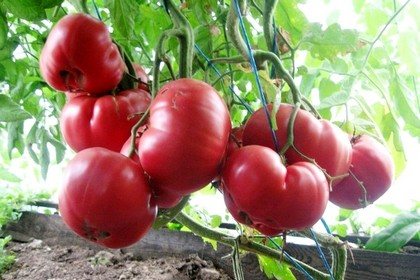

The young variety King of Giants is quickly mastered in the beds, thanks to its advantages:
- Large vitamin indicator;
- High yield;
- Excellent taste and consistency;
- Unpretentious care;
- High rate of seed germination;
- Calm reaction to a slight temperature drop;
- Immunity to standard diseases;
- Good transportability;
- Large mass of fruits;
- Long-term storage of the crop;
- Endurance when transplanting and picking;
- Not being a hybrid, the culture allows self-harvesting of seeds.
However, there are no perfect varieties. Even with all the many positive qualities, the King of Giants has 5 negative points:
- Low light sensitivity;
- Obligatory tying;
- The need for systematic feeding;
- Capitulation to the whitefly;
- Seedlings are demanding on transplant conditions.
Yield
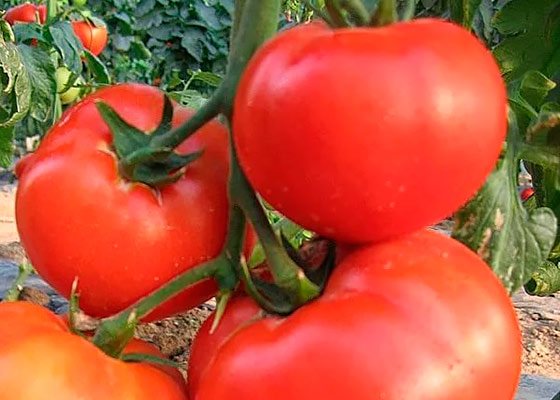

The large-fruited non-hybrid variety increases in popularity every year. This is facilitated by the possibility of growing tomatoes in any region of the country.In open beds, a tomato can only be cultivated in southern latitudes, while greenhouse conditions make it possible to plant the variety in regions of a more severe climate.
Ripening of tomatoes begins from 16 weeks from germination. It is quite possible to remove 9 or more kg of fruits from each bush.
Compliance with agricultural techniques and some useful recommendations can increase this indicator.
Other large-fruited varieties:
Brief information about the variety
- Fruit and bush: purple tomatoes (completely or in places), flat-round shape, weight - from 150 to 500 g; determinant bush, 80-130 cm high.
- Yield: unstable, can be medium or high (4 to 10 kg per bush).
- Sustainability: high for major diseases.
- Spread: recommended for greenhouse cultivation in the regions of the middle zone of the Russian Federation, in the south it can be cultivated in the open field.
- Application: salads, cuts, vegetables, freezing, processing (juices, ketchup, pasta).
- Landing: seedling method; sowing - in mid or late March; transfer to a greenhouse - in early or mid-May, in open ground - at the end of May; scheme - 50 × 70 cm.
- The soil: light, fertilized with humus.
- Care: watering - once every 8-10 days, feeding - every 2-3 weeks, shaping - in 1-2 stems, tying up the stems and fruit brushes - a must.
- Periodripening: mid-season - fruits are harvested 110-115 days after germination. Storage - 1-1.5 months.
Features of growing and care
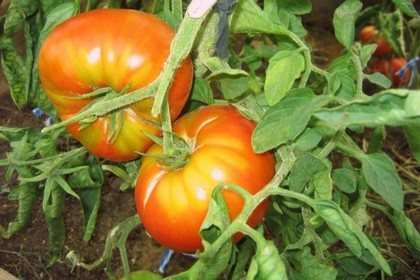

Experienced gardeners who grow the King of Giants variety are advised to independently deal with seedlings. Seeds, not more than 2 years old, must be purchased from reliable distributors. The planting material should be treated with special preparations that prevent the development of fungal infections.
Untreated seeds can be disinfected by yourself with a manganese solution. The maximum processing time should not exceed 30 minutes. Water is used warm, settled, not containing impurities.
The soil is used standard, intended for indoor plants. The seeds are placed at a depth of 0.5 cm, maintaining a gap of 2 cm between them. They dive according to the standard rule.
Before planting in open beds or greenhouses, the seedlings are hardened for a week.
Important! To get a high yield, seedlings need strict temperature and light control.
There is no need to be greedy, to thicken the plantings - this will negatively affect the quantity and quality of tomatoes. The optimum density is 2 plants per 1 m².
It is very important for the King of Giants to form the bush correctly. It is enough to leave 2 stems, but not more. The stepsons are removed in a timely manner.
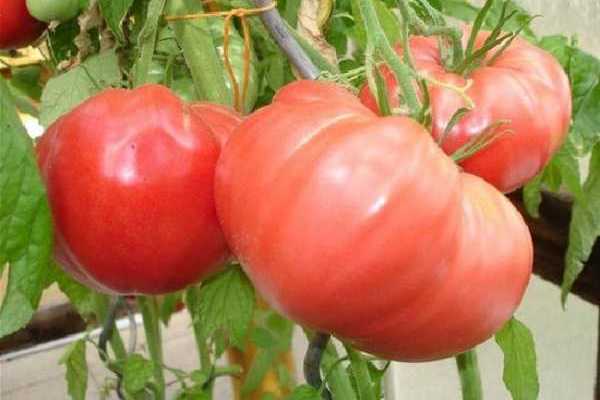

Further care of the plant consists in watering, loosening, weeding. HIn order to maintain the tone of the tomato, the following crops are determined in its neighbors:
- Dill;
- Parsley;
- White cabbage;
- Sorrel.
- The neighbors-cucumbers will increase the tomato harvest.
Tomatoes are fed with their favorite nitroammophos and superphosphate. They will not give up the infusion of nettle, organic matter. The feeding scheme is planned in advance, and then strictly adheres.
Also, plants are being treated against the whitefly butterfly, which can cause enormous damage.
Prophylaxis
To prevent the development of various fungal diseases, it is necessary to spray the plants with Fitosporin, which is safe from an environmental point of view. In the event that only the plants are already infected, you need to use special preparations that are sold in stores for the sake of gardeners.
Plants of this variety require special and constant care, without which it is impossible to get a high yield. Only in this case will the fruit be large, juicy and fleshy, and will have good taste.
Reviews of gardeners who planted
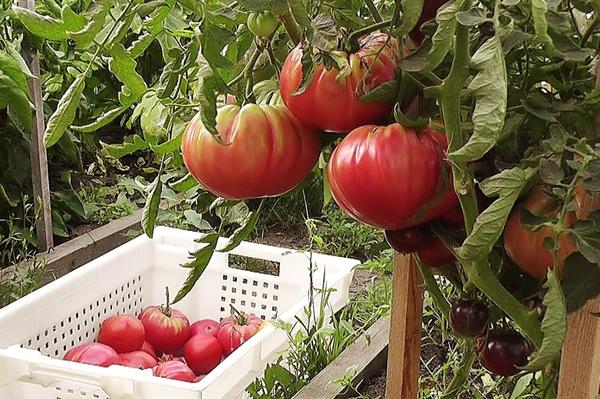

It is not in vain that the King of Giants bears such a title, this is confirmed by good reviews about him.
Irina, Stavropol
I have been growing this variety for a couple of seasons, and I will not refuse further plantings. The first time my friends offered me seeds, and now I am collecting my own. Tomatoes grow in the wild, I plant 3 bushes per meter, I leave 2 stems in each. Stepson very often, as the bushes overgrow quickly.
The record yield promised by breeders has never been observed. On average, each fruit weighed 400 g, but the taste is simply delicious. Tomatoes have shown themselves to be excellent in processing, especially lecho.
Nadezhda, Ryazan
The King of the Giants variety is offered by two selection stations - the Russian vegetable garden and the Siberian garden. I grow both varieties. They are similar in some characteristics, but their shape is different: some are smooth and absolutely round, others are slightly flattened.
I also noticed that even in one package there is a re-grading: a couple of bushes gave not red fruits, but bright crimson ones. Tomato tastes wonderful and has a pleasant aroma. They made salads every day and couldn't boast.
But the dimensions seemed to be lower than those stated. The largest tomato weighed 500 g. I saw the seeds of the King of Giants marked "F1" on sale, but the characteristics indicate that this variety is natural. Now I doubt whether to sow my own seeds or not.
Maxim, Ufa
Read also: Malina Arbat: variety description, photos, reviews
I got planting material from the Ural summer resident. Although the King of Giants fruit did not reach 800 g, in general they were very large, so I was not disappointed. The first crop was almost entirely eaten, only a little was left for the sauce.
A tomato grew in a greenhouse, but there were problems. I am a little lazy person, but here it was necessary to radically pinch, and plant less often. A thickened bush begins to suffer from a lack of light.
And with feeding it was necessary to hurry up: a hungry bush gives little ovary, and even those grow smaller. There is no lack of accurate data on diseases in the description, so I processed everything in a row. The uncertainty with the tomato is also embarrassing: on the Internet, it is the King of Giants variety that is represented by a variety - both a hybrid, and yellow, raspberry. Some kind of confusion. I will hope for my own seeds, maybe they will retain the traits I like.
Growing tomatoes
The rules for preparing seeds, growing and planting seedlings are very important for a healthy harvest and you can read more about them below.
How do I prepare the seeds?
To get healthy bushes, you need to prepare seeds, and for this conduct a number of such events:
- Disinfection. Before planting, seeds must be treated with a weak solution of potassium permanganate in order to kill a possible fungal infection contained in some of them.
- Treatment with bioactive substances. To make the bushes grow strong and healthy, they can be treated with aloe juice. To do this, the seeds are placed in juice for 12 hours, then taken out and allowed to dry.
Sowing seed
For sowing seeds, small pots are filled with soil purchased from a store or make up a mixture with your own hands from:
Sowing is carried out in late February - early March according to the following algorithm:
- Grooves are made in the soil and seeds are placed in them;
- Top with peat;
- Water from a spray bottle;
- Cover the pots with foil and place them in a warm and dark place until sprouts appear;
- Remove the film and place in a cooler and brighter place.
Seedling planting rules
Transplanting seedlings from pots is carried out at the end of May. To do this, dig three holes on one square meter, fertilize their bottom and cover them with ash. After that, the root system of the seedlings is placed in the holes and sprinkled with earth. Then watered at the root.
Detailed description of the variety
The Ural giant tomato is an indeterminate variety (during the vegetative period, the plant does not stop growing).
The plant is tall, reaching a height of 1.5-2 m, therefore, in order to avoid breaking or bending, the bush needs high-quality support. Mid-early tomato Ural giant forms a powerful bush, densely covered with dark green foliage. A powerful stem rapidly tends upward, forming new brushes each time.
The first flower cluster appears under the 9th leaf, 100 days after sprouting. To get a good harvest, the plant needs help with pollination. To do this, they attract insects, often ventilate the greenhouse or carry out pollination by hand.
The Ural Giant tomato variety grows well in hotbeds and greenhouses in the Urals, Altai, Siberia, the North-West and the Moscow region. In the open sun, the variety is grown in the southern regions and post-Soviet countries.
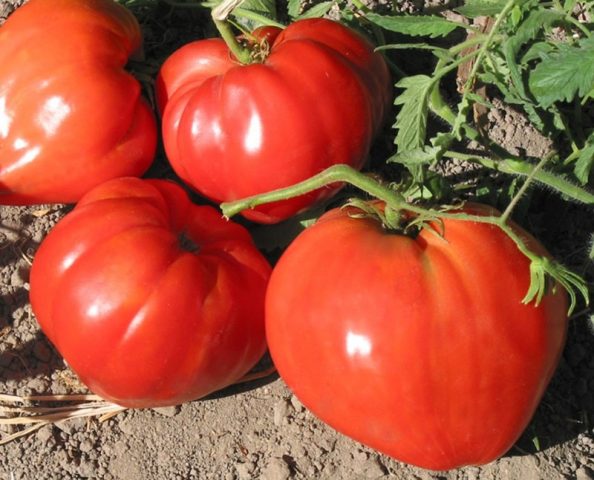

Brief description and taste of fruits
The Ural giant tomato is bred for cultivation both in open beds and under a film cover. The variety combines 4 types. They are distinguished by color. They come in red, pink, yellow, and orange. Each species has its own taste, aroma, positive and negative qualities:
- the red giant is rich in lycopene;
- pink has the sweetest flesh;
- yellow - has an unusual taste;
- orange - contains vitamin A.
Despite the color, with proper care, tomatoes grow large, weighing up to 900 g. Round-flattened multi-chamber tomatoes contain a small amount of medium seeds. The thin skin protects the juicy, sweet pulp during transport.
Ural Giant tomatoes are used fresh, for making salads, ketchup, adjika, cold sauces and juice. You can also boil tomato paste, colorful lecho and cook slices under a jelly marinade.
The origin of giant varieties
When developing varieties of giant tomatoes, the main goal of breeders was to achieve large sizes and improve the palatability of the fruit.
As a result, tomatoes have been developed with large fruits and an original sweet taste. The pulp of giant tomatoes is pleasant to the taste and contains an increased amount of sugars, lycopene and provitamin A.
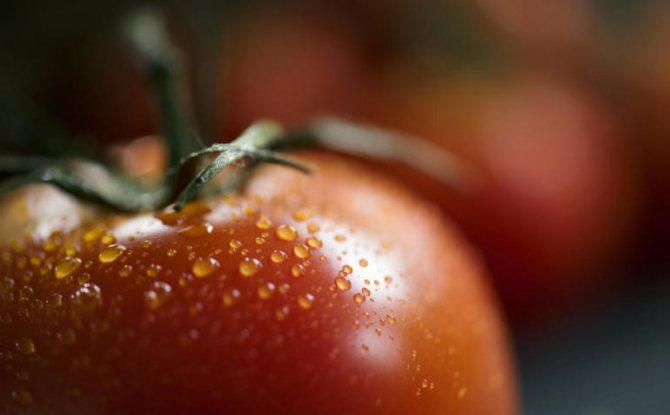

Varietal characteristics
The Ural giant tomato is a high-yielding variety, with proper care from 1 sq. m can be collected 15 kg and more. The high yield is explained by the fact that the plant produces 3-5 large fruits on each brush. As a rule, the first harvested crop grows much larger than the subsequent fruits. If the task is to grow giant tomatoes, then it is necessary to thin out the flower brushes every 7 days.
The yield is influenced not only by the characteristics of the variety, but also by climatic conditions, the region of growth and compliance with the rules of care.
Tomatoes of the Ural Giant variety are moderately resistant to diseases. Often the tomato bush is affected by:
- late blight - leaves and fruits are covered with dark brown spots;
- brown spot - round yellow spots appear on the outside of the leaf, a brown velvety bloom forms on the inside;
- cracking of fruits - a defect in the fruit occurs due to irregular watering;
- macrosporiosis - brown spots are formed on the leaf plate, trunk and cuttings.
To protect the Ural Giant tomato from unexpected guests, preventive measures must be followed:
- observe crop rotation;
- carry out an autumn digging of the site;
- before planting a culture, spill the soil with boiling water or a solution of potassium permanganate;
- grow seedlings from proven seeds that have passed the disinfection stage.
Pros and cons of the variety
The Ural giant tomato has its positive and negative sides. The advantages include:
- high productivity;
- large mass of fruits;
- the variety is resistant to sudden changes in temperature;
- good taste and rich aroma;
- tomatoes have a high content of vitamins and minerals.
The disadvantages of many summer residents include the inability to maintain integrity during long-term transportation, instability to diseases and a garter to the support.
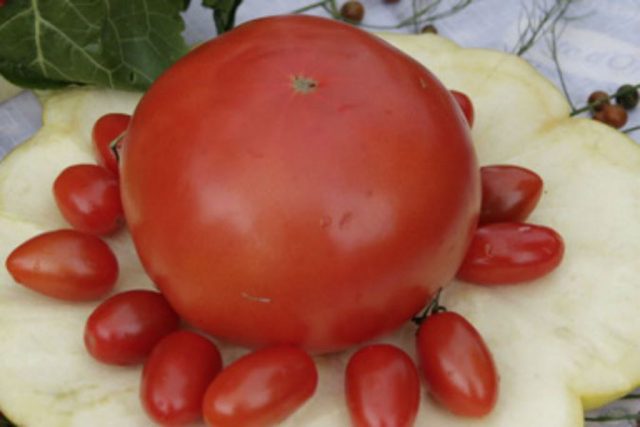

Diseases and pests
Tomato variety "Azure Giant F1" is quite resistant to the main diseases of the nightshade. It is not susceptible to mosaics, fusarium wilting, verticillosis, spotting. However, one cannot do without preventive measures, they guarantee a high yield of tomatoes. Before planting, the soil is cleared of weeds and spilled with a solution of potassium permanganate or copper sulfate. The plantings are periodically sprayed with phytosporin or another non-toxic bio-preparation with an antifungal effect.
You can get rid of pests by regularly weeding and mulching the soil with straw or peat. Large larvae and naked slugs are collected by hand. Plants affected by aphids can be washed with an aqueous solution of laundry soap, and insecticides are good for flying insects. It is recommended to use them only before the fruiting period.
“Azure Giant F1” is a variety ideal for experimentation. You can increase yields by using complex mineral fertilizers, observing the irrigation schedule and adjusting the temperature.
| Mid-season | Medium early | Late ripening |
| Anastasia | Budenovka | Premier |
| Raspberry wine | The mystery of nature | Grapefruit |
| Royal gift | Pink king | De Barao Giant |
| Malachite Box | Cardinal | De Barao |
| Pink heart | Babushkino | Yusupovsky |
| Cypress | Lev Tolstoy | Altaic |
| Giant crimson | Danko | Rocket |
If you find an error, please select a piece of text and press Ctrl + Enter.
Planting and care rules
The growth and development of the future bush depend on properly grown and planted seedlings. Under some conditions, on the part of the gardener, the Ural giant tomato will thank it with large, sweet and fragrant fruits.
Sowing seeds for seedlings
To grow full-fledged seedlings, it is necessary to create optimal conditions for the seedlings:
- additional lighting;
- maintaining high humidity;
- for good development, the temperature in the room should be + 18-23 ° С during the day, + 10-14 ° С at night.
Read also: Cucumber Emerald F1 Earrings - reviews of the variety, description, photo
To grow healthy, strong tomatoes that will bring a rich harvest, you need to heed the advice of experienced gardeners:
- Seeds are disinfected before sowing. To do this, the seed can be soaked for 10 minutes in a weak solution of potassium permanganate, in a 0.5% soda solution, in aloe juice or in the "Fitosporin" preparation.
- Prepare the soil. It can be purchased at the store, or you can mix it yourself (sod land, peat and humus are taken in equal proportions, mineral fertilizers are added and mixed thoroughly).
- Plastic cups with a volume of 0.5 ml or boxes 10 cm high are filled with nutrient soil and spilled with boiling water or a weak solution of potassium permanganate.
- Seeds are sown to a depth of 1 cm, covered with earth and covered with polyethylene or glass to maintain a favorable microclimate.
- For rapid germination, the temperature should be within + 25 ° C, so the container is removed to the warmest place.
- Before the emergence of sprouts, watering is not carried out, since the condensate accumulated on the film will be enough for irrigation.
- After 2-3 days, when sprouts appear, the shelter is removed, and the container is rearranged in a well-lit place. With a short daylight hours, the seedlings must be supplemented. The first 2-3 days the seedlings are illuminated around the clock, then the total duration of daylight hours should be at least 15 hours.
- When growing seedlings, the top layer must not be allowed to dry out. If necessary, young shoots are irrigated in the morning or in the evening with warm, settled water.
- The first feeding is carried out one month after the emergence of sprouts. For this, fertilizers based on humus are suitable; when feeding, you must strictly adhere to the instructions.
- When 2-3 true leaves appear, the seedlings dive. For this, seedlings growing in boxes are transplanted into 0.2 liter cups. After a month, you can carry out a second pick in a container with a volume of at least 500 ml. When sowing seeds in separate cups, picking is carried out immediately in a 0.5 liter container.
- At the age of 45 days, tomatoes are prepared for transplantation to a permanent place. 2 weeks before planting, the seedlings are hardened, daily increasing the period of stay in the fresh air.
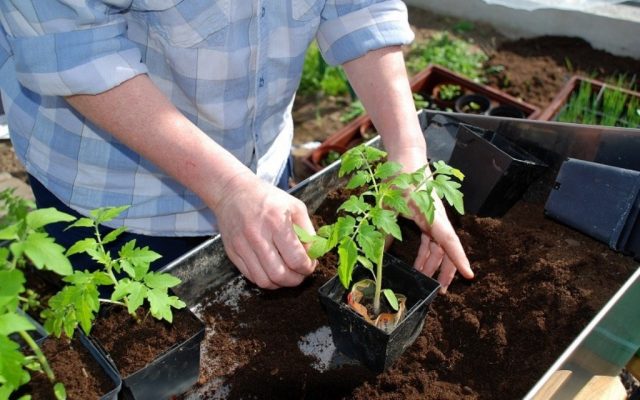

Transplanting seedlings
Good tomato seedlings should have a strong trunk, large leaves, a well-developed root system and well-formed buds.
The Ural giant is planted in cloudy, cool, calm weather. Tall tomatoes of the Ural Giant variety are planted in prepared, spilled holes at an acute angle or in a prone position. Over time, the buried trunk will build up a root system, which will help the plant to form a large number of fruits. After planting, the tomatoes are spilled with warm, settled water, the earth is mulched. In order for the plants to receive a sufficient amount of sunlight, per 1 sq. m planted 3-4 bushes.
Planting care
The quantity, quality and size of tomatoes depends on correct and timely care. There are 10 commandments for care that must be followed by responsible gardeners growing the Ural giant tomato:
- Watering and feeding is carried out 12 days after planting. Further, at least 2 liters of warm, settled water are spilled under each bush. Top dressing is carried out 3 times per season: during active growth and build-up of the root system, during the formation of 2 brushes and during the ripening period of the first tomatoes.
- You need to form a plant in 2 stems. To do this, leave the stepson formed under the first flower brush. All the other stepchildren are cleaned every week until they have grown 3 cm. For quick healing of the wound, the work is carried out on a sunny day.
- If double flowers appear on the ovaries, they are ruthlessly removed, as ugly fruits appear from them. Also, such flowers take a lot of strength from the plant, and it stops in development.
- During the ripening period of the fruit cluster, the lower leaves are removed, but not more than 3 per week.
- Flower brushes can be thinned if desired. Since with a smaller number of fruits, their mass increases significantly.
- Since the Ural giant tomato grows up to 2 m, it must be tied to a strong trellis. When the garter is tied, the stem is twisted clockwise so that the thread does not interfere with the plant during the rotation behind the sun.
- Heavy brushes and large tomatoes are tied separately so that the plant does not bend or break under the weight.
- If the weather is hot, tomatoes are manually pollinated. To do this, the bush is slightly shaken 2-3 times a day. Such work is carried out from 8 to 11 o'clock in the morning, since at this time the pollen of the flower spills out well on the pistil.
- Although the Ural giant tomato is resistant to cracking, it is necessary to water it on time several hours before sunset.
- In autumn, those tomatoes ripen, which managed to set before August 1. Therefore, in August, all flower brushes are removed, and the top is pinched, leaving 2 leaves above the last fruit. To ripen the tomatoes faster, the bush is fed with potassium-phosphorus fertilizers, and watering is reduced.
Features of agricultural technology of giant tomatoes
The characteristics and description of the variety indicated on the package must be read before purchasing seeds - there may be fundamental points. To prepare seeds for planting - disinfect in a solution of potassium permanganate, rinse in warm water and remove for several days in a cool place. Then the seeds are soaked, and when the first shoots appear, they are planted in prepared pots. Sowing seeds for seedlings is carried out from the third decade of March to the first decade of April. Sowing later may result inthat the fruits will not reach large sizes.

